- City Fajr Shuruq Duhr Asr Magrib Isha
- Dubai 04:32 05:49 12:21 15:48 18:47 20:04

After almost two months on Mount Everest we finally got the news we had been waiting for – a weather window was arriving, which would allow us to make a push for the summit!
My team, consisting of eight Western climbers, eight local Sherpas and two Western guides set off from Everest Base Camp (EBC), at 5365m altitude, at 0300 on the morning of May 15th.
Our early start was to help us pass the infamous Khumbu Icefall before the heat of the day started melting the snow and ice and making it extremely dangerous.

The crevasses and daily avalanches of the Khumbu Icefall had already claimed several lives this season and we didn’t want to be additions to those statistics.
We trekked in pitch-black with our way lit only by our headlamps.
As we got close to the Khumbu Icefall, we suddenly heard the sound of a major avalanche on Nuptse, a 7861m mountain just a hundred meters away.
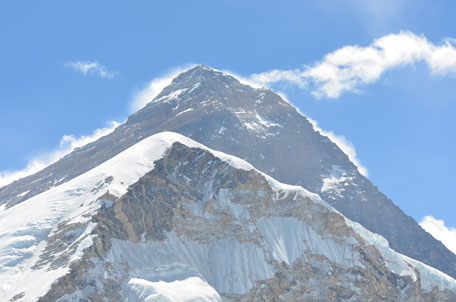
Shortly afterwards we were sprayed by snow from the avalanche, but fortunately that’s as bad as it got!
We reached Camp 2 in the early afternoon and were happy to find out we would have a rest day before continuing up the mountain.
After the rest day, we continued to the base of the Lhotse Face, a beautiful but dangerous wall of snow and ice that rises over one kilometre almost straight up.
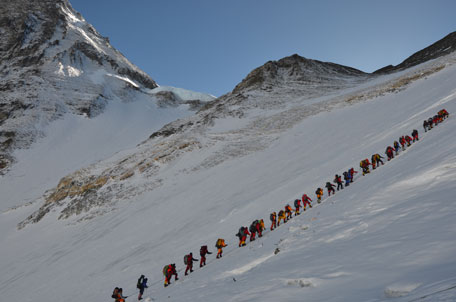
At the base of the face, we put on our oxygen masks, switched on our supplemental oxygen for the first time and started climbing.
The Lhotse Face is very steep, so we essentially climbed with the help of fixed ropes all the way.
On the way, we came across tents completely destroyed by an avalanche. Unfortunately a Sherpa had also been on the path of the avalanche - he was breathing, but in a lot of pain, after a serac, a falling piece of ice, had broken both of his femurs.
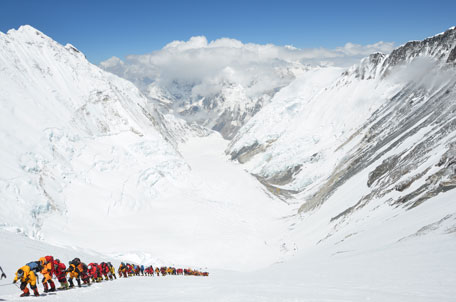
Camp 3 was located at 7400m on a ledge with just enough space for a few tents.
We literally spent our entire time at the camp inside the tents – reminded by a story of a Japanese climber who stepped outside of his tent in 1996 to go to the bathroom, slipped, and slid down the entire 1000 meters of the Lhotse Face.
The following morning we were preparing to make the move to our final camp, Camp 4, at 7900m, when a small avalanche hit my tent. It wasn’t dangerous, but enough to remind me of who’s king around here.
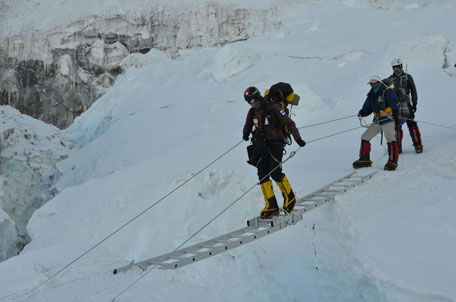
The morning brought some bad news. Mike, our lead guide, had gotten sick and was not able to continue.
He was heading back down to base camp with one of my teammates who was also sick, so we were now down to seven Western climbers and one guide.
We would find out later that my teammate was suffering from potentially fatal pulmonary edema, so he was lucky to go down.
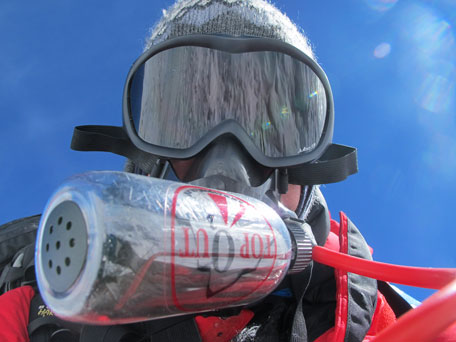
When it was time to get moving again, I got completely shocked.
World’s highest traffic jam
Over the past years, Mount Everest has become a popular destination, but I wasn’t expecting over 200 people moving in a queue up the mountain causing a traffic jam!
I had no choice but to join the snail train up the mountain – there’s only one safety rope on the Lhotse Face, so trying to start passing people is a very dangerous game to play.
Not that being stuck to a rope on a steep mountain is that much safer – over the next few hours, I watched several oxygen bottles, a water bottle and a camera fly by – and counted my lucky stars for not getting hit by any of them which were travelling at high velocity.
Some 6.5 hours later I finally reached Camp 4 close to the “Death Zone”. The Death Zone is a term used by climbers to refer to the altitude above 8000m.
Human life cannot be sustained above this altitude, so rather than living, climbers are technically dying slowly the entire time they spend above 8000m, especially if without oxygen.
Concerned about the traffic jam between Camp 3 and Camp 4, we made a decision to start our final summit push early, which meant 2000 the same evening.
We had been warned that during the summit push, the average climber burns around 15,000 calories, six days worth of energy for a normal man, and hence we needed to eat and drink as much as possible.
However, one’s digestion system shuts down at this altitude and instead your body burns fat and muscle for energy, so I didn’t have such good luck eating and drinking, with my mind focused on the summit push instead.
I couldn’t sleep either, so I started preparing early and was ready well before 2000 and I was first to set off for the summit from my expedition.
The route from Camp 4 to the top of the world is difficult. It took me about 3.5 hours to reach the Balcony, at 8400m, where I changed oxygen bottles before continuing to the South Summit, at 8750m. Just to put things into perspective, I consider myself pretty fit and I was moving at less than 150 vertical meters per hour!
No masking this
I struggled to reach the South Summit and after finally reaching the top, I realised why – my oxygen mask had broken and I was now only breathing ambient air – with roughly 30% of the oxygen we’re used to at sea-level.
There was no way to fix the mask, so I had to take the mask from my Sherpa, Pemba Dorjee, and send him back down to Camp 4 with the broken one, ending his chance to reach the summit.
I then continued towards the summit and soon found myself staring at the almost vertical 12 foot Hillary Step, named after Sir Edmund Hillary, who was the first person to summit Mount Everest in 1953. I pushed myself hard to climb the Hillary Step and soon after, found myself on the exposed summit ridge.
I felt very tired and moved slowly. I reached the summit just as the sun began to rise in the horizon and brought with it a beautiful glow around the mountains surrounding Everest.
It would have been great to stay and admire the sunrise for longer, but the weather was much colder than expected, around -40C and combined with heavy winds, made it the “ideal conditions” for developing serious cold injuries, such as frostbite.
I preferred to make my descent without frostbite on my fingers or toes, so rather than take my chances, I decided to head down early!
By the time I started down, there was a major traffic jam of people on the narrow ridge leading to Hillary Step.
The ridge has several kilometres of emptiness on both sides and with only one safety rope for the two way traffic to use, I manoeuvred around people very carefully, remembering that most accidents on Everest happen on the way down.
It took me about five hours to reach the relative safety of Camp 4, where I collapsed into my tent or what I thought was my tent – I found the right one on the third try!
My plan had been to descend to Camp 2 after the summit but my summit push, which had taken me about 14 hours, had wiped me out, so I decided to spend another night at the South Col at 7900m.
The night was bad. I ran out of oxygen and was unable to sleep I just waited for the morning to arrive.
When the morning eventually came, I got a new bottle of oxygen and headed down the mountain with my sherpa Pemba Dorjee. We made good time and reached Camp 2 in about four hours, tired but happy to be in thicker air, where we no longer needed bottled oxygen.
Death in heaven
While at Camp 2 I learned that five of our seven climbers as well as Andy, our guide, had made it to the summit. Few of my teammates had experienced similar situations as I did with my oxygen, but fortunately everyone returned alive. Four climbers from other expeditions had perished during their summit bids on the same route as us.
However, not everyone was equally lucky. An American teammate of mine, arrived to Camp 2 and mentioned in passing he couldn’t feel his toes. I asked to have a look at them and recognising obvious signs of frostbite we ended up having Duane evacuated by helicopter. He’s now at home in the US facing months of recovery, which will hopefully save the toes of his right foot as well as his thumb.
Early next morning we continued down to Everest Base Camp (EBC). It was a great feeling to pass the Khumbu Icefall for the very last time, see our camp and be welcomed by the camp staff – knowing that we were done and out of danger. Getting altitude related problems after returning to EBC is highly unlikely so reaching EBC is kind of like reaching the finish line of a marathon...or well, a series of marathons.
A couple of hours later, I had packed my bags and was sitting on a helicopter on the way to Kathmandu, thinking about what an awesome adventure I had just been part of...
MUST READ:
UAE resident conquers Mt Everest
Terrifying moment when part of Swiss Alps disappeared
Climbing Mt Everest - Dubai resident faces avalanches, rock falls, strokes…
![]() Follow Emirates 24|7 on Google News.
Follow Emirates 24|7 on Google News.